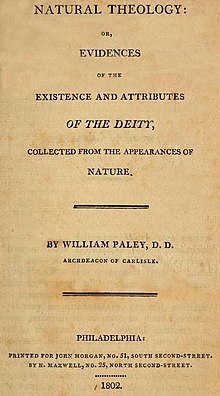Natural Theology or Evidences of the Existence and Attributes of the Deity

Title Page of first American edition
|
|
| Author | William Paley |
|---|---|
| Language | English |
| Genre | Christian apologetics, philosophy of religion |
| Publisher | R. Faulder, London John Morgan, Philadelphia |
|
Publication date
|
1802 |
Natural Theology or Evidences of the Existence and Attributes of the Deity is an 1802 work of Christian apologetics and philosophy of religion by the English clergyman William Paley (July 1743 – 25 May 1805). The book expounds his arguments from natural theology, making a teleological argument for the existence of God, notably beginning with the watchmaker analogy.
The book was written in the context of the natural theology tradition. In earlier centuries, theologians such as John Ray and William Derham, as well as philosophers of classical times such as Cicero, argued for the existence and goodness of God from the general well-being of living things and the physical world.
Paley's Natural Theology is an extended argument, constructed around a series of examples including finding a watch; comparing the eye to a telescope; and the existence of finely adapted mechanical structures in animals, such as joints which function like hinges or manmade ball and socket joints. Paley argues that these all lead to an intelligent Creator, and that a system is more than the sum of its parts. The last chapters are more theological in character, arguing that the attributes of God must be sufficient for the extent of his operations, and that God must be good because designs seen in nature are beneficial.
The book was many times republished and remains in print. It continues to be consulted by creationists. Charles Darwin took its arguments seriously and responded to them; evolutionary biologists like Stephen Jay Gould and Richard Dawkins continue to discuss Paley's book to respond to modern proponents with similar ideas.
The main thrust of William Paley's argument in Natural Theology is that God's design of the whole creation can be seen in the general happiness, or well-being, that is evident in the physical and social order of things. This sets the book within the broad tradition of the Enlightenment's natural theology; and this explains why Paley based much of his thought on John Ray (1691), William Derham (1711) and Bernard Nieuwentyt (1750).
...
Wikipedia
